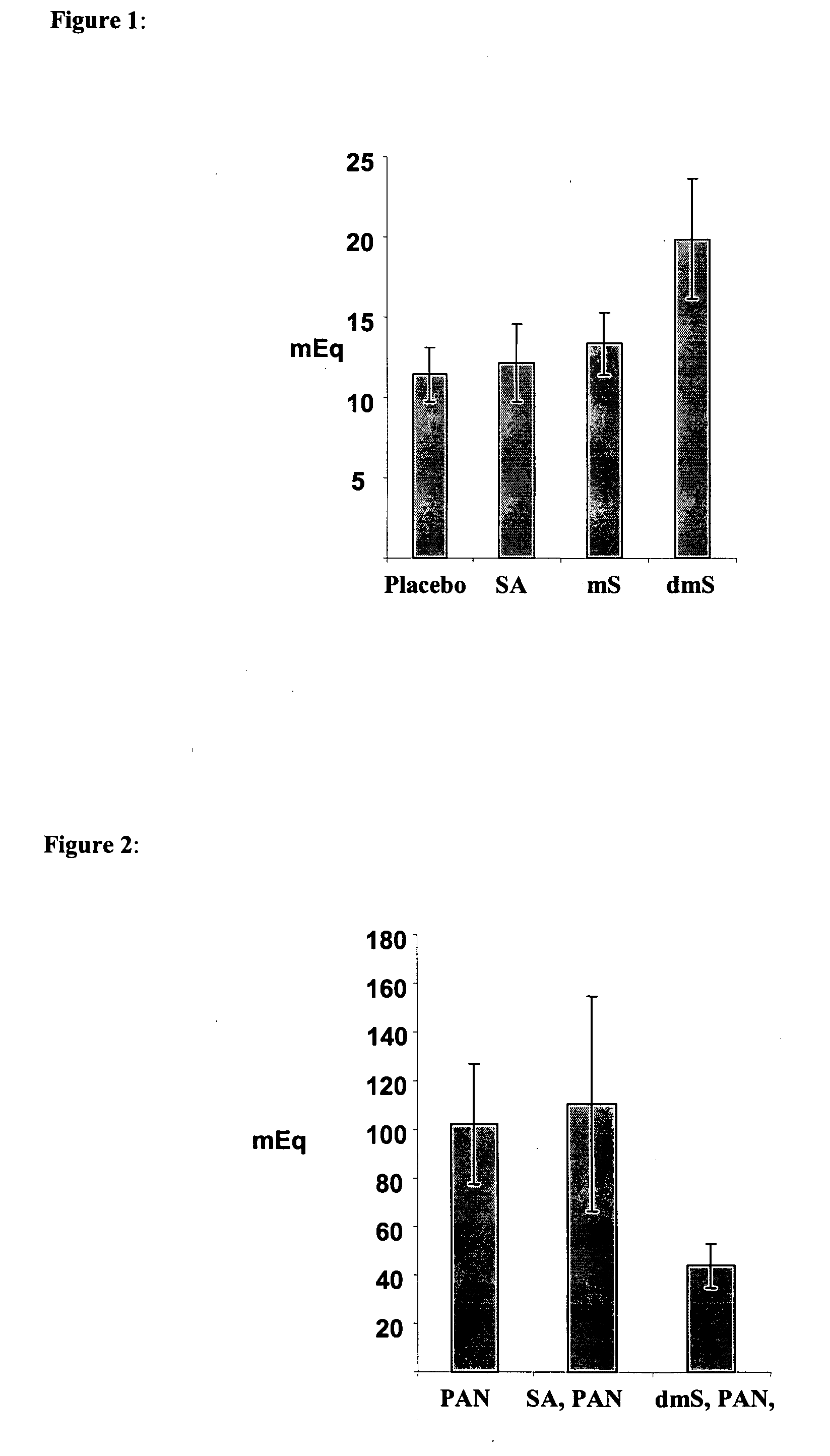Compositions and Methods For Inhibiting Gastric Acide Secretion Using Derivatives of Small Dicarboxylic Acids in Combination with PPI
a technology of dicarboxylic acid and gastric acid, which is applied in the direction of antibacterial agents, drug compositions, biocide, etc., can solve the problems of limiting the usefulness of on-demand gerd therapy of ppis, ppis have notable limitations, and ppis have a relatively low onset of pharmacological action, so as to achieve enhanced activity in inhibiting gastric acid secretion
- Summary
- Abstract
- Description
- Claims
- Application Information
AI Technical Summary
Benefits of technology
Problems solved by technology
Method used
Image
Examples
example 1
Stimulation of Gastric Acid Secretion Following Oral Administration Of Sodium Succinate, Monomethylester or Dimethyl Ester of Succinic Acid in Rats
[0080]Rats were administered (per os) with succinic acid (SA, 14.88 mg / kg), monomethylester of succinic acid (mS, 16.65 mg / kg) or dimethyl ester of succinic acid (dmS, 17.65 mg / kg) using gavage. 60 minutes later the rats were anesthetized with ketamine / domitor and the pylorus was ligated. Following additional 30 min, gastric juice was collected from the gastric lumen. Acid output was determined by titration with NaOH. Total acid output expressed in mEq HCl was calculated by multiplying the sample volume by the acid concentration. Results are expressed as means ±SEM of 8 animals from each experimental group. As demonstrated in FIG. 1, oral administration of dimethyl ester of succinic acid (dmS) as well as the monomethyl ester of succinic acid (mS) were effective in enhancing gastric output. SA did not show an effect when given 60 minutes p...
example 2
Dimethyl Ester of Succinic Acid is Capable of Enhancing the Activity of Pantoprazole on Gastric Acid Secretion
[0081]To further study the delayed or sustained enhancement effect of dimethyl ester of succinic acid on the activity of pantoprazole, an experimental model of conscious pylorus-ligated rats was used. This experimental model permits the analysis of the effect of drugs on gastric acid secretion in conscious animals and avoids the effect of anesthesia on gastric acid secretion. Pantoprazole alone (3 mg / ml) or in combination with succinic acid (SA, 14.88 mg / kg) or dimethyl ester of succinic acid (dmS, 17.65 mg / kg) were administered by oral gavage. The succinates were administered 30 min prior to the administration of pantoprazole in order to test the sustained or delayed effect of dimethyl ester of succinic acid compared to the non-derivatized succinic acid. 120 min post succinates administration, the animals were anesthetized using anesthetic gas machine for a short period (5 ...
example 3
Oral Formulations Comprising a Proton Pump Inhibitor (PPI) and Dimethyl Ester of Succinic Acid
[0083]Hard Gelatin Capsules
[0084]Hard gelatin capsules may contain a mixed granules population of dimethyl ester of succinic acid (DMS) and PPI. DMS is in an immediate release formulation and PPI is formulated as enteric-coated granules or time-dependent release coating (delayed release). Granules may be packed into a hard gelatin capsule in an amount corresponding to 40 mg PPI and 600-700 mg DMS per capsule. Alternatively, each compound may be packed in an individual capsule while those capsules are packed together in a single capsule. Another possibility is that each compound may be separated using a double chambered capsule.
[0085]A) Immediate release DMS formulation:[0086]40 mg enteric-coated (Eudragit) or time-dependent release coated (HPMC) PPI granules[0087]600-700 mg DMS[0088]diluent
[0089]Tablets or Caplets
[0090]The pharmaceutical composition may be in the form of tablet or more pref...
PUM
| Property | Measurement | Unit |
|---|---|---|
| Time | aaaaa | aaaaa |
| Time | aaaaa | aaaaa |
| Mass | aaaaa | aaaaa |
Abstract
Description
Claims
Application Information
 Login to View More
Login to View More - R&D
- Intellectual Property
- Life Sciences
- Materials
- Tech Scout
- Unparalleled Data Quality
- Higher Quality Content
- 60% Fewer Hallucinations
Browse by: Latest US Patents, China's latest patents, Technical Efficacy Thesaurus, Application Domain, Technology Topic, Popular Technical Reports.
© 2025 PatSnap. All rights reserved.Legal|Privacy policy|Modern Slavery Act Transparency Statement|Sitemap|About US| Contact US: help@patsnap.com

